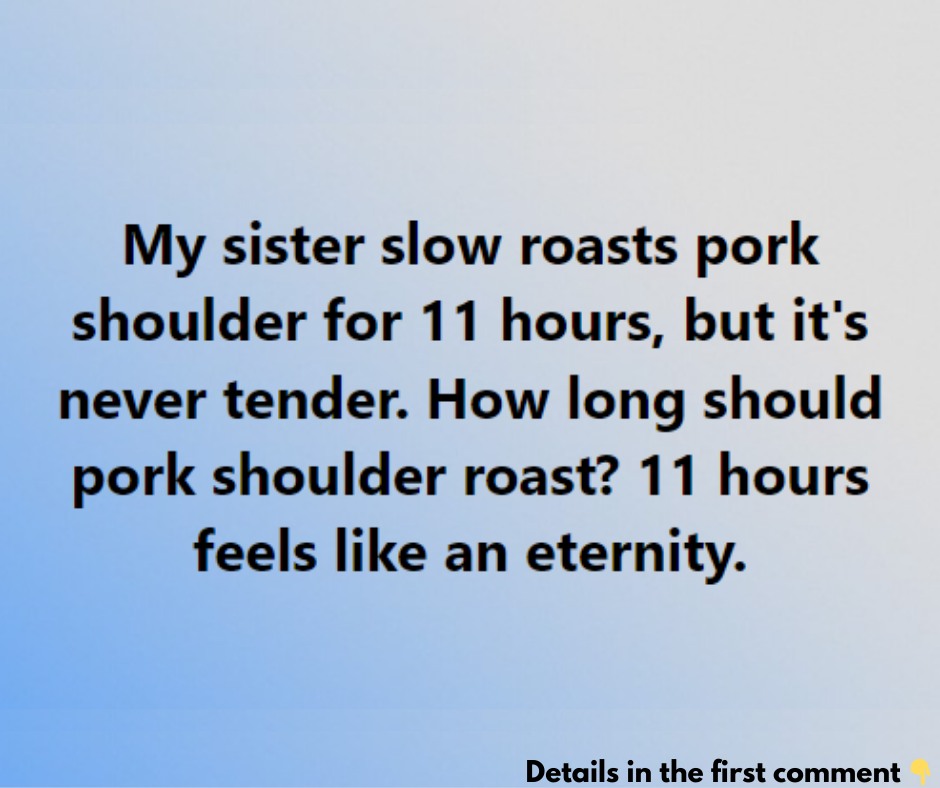My sister has been slow-roasting pork shoulder for 11 hours, but it’s still not tender. If you’ve been in a similar situation, it can be frustrating to spend so much time cooking only to end up with tough meat. The truth is, while slow-roasting pork shoulder is a tried-and-true method for turning a tough cut into something deliciously tender, it’s not just about the time. Other factors like temperature and technique play a crucial role in getting that perfect, melt-in-your-mouth roast.

In this article, we’ll dive into the science of slow-roasting pork shoulder and cover key elements like oven temperature, cooking time, and tips for ensuring a tender result. Let’s explore what might be missing from your approach to transform your next pork roast into the tender feast you’re aiming for.
The Science of Slow-Roasting Pork Shoulder
Pork shoulder, also called pork butt, is a fatty, tough cut of meat that needs time to break down its connective tissues. The slow-roasting method is designed to apply gentle heat over several hours, allowing the fat to render and the connective tissue to dissolve into gelatin, which creates that tender, juicy texture.
Though 11 hours may sound like enough time, several other factors could be impacting your roast’s tenderness. Let’s look at what you need to keep in mind.
1. Oven Temperature Is Key
One of the most common mistakes is cooking pork shoulder at the wrong temperature. If the oven is too hot, the meat can dry out before the collagen has a chance to break down. On the flip side, if the temperature is too low, the pork may not cook evenly.
The ideal range for slow-roasting pork shoulder is between 225°F and 275°F (107°C to 135°C). This steady, low temperature ensures the fat and connective tissue break down gradually, resulting in tender meat. Use an oven thermometer to make sure your oven is holding a consistent temperature throughout the process.
2. Maintain Consistent Heat
If your oven doesn’t maintain a consistent temperature, it can result in uneven cooking. This can leave some parts of the roast tough while other parts overcook. If you suspect your oven has temperature fluctuations, check its calibration or use an oven thermometer to ensure consistent heat.
3. Quality and Preparation of the Meat
The quality of the pork shoulder you use can also affect the tenderness. A leaner cut of pork won’t have enough fat to break down and keep the meat moist, resulting in a tougher roast. Additionally, bringing the pork to room temperature before roasting and seasoning or brining it beforehand can improve both tenderness and flavor.
How Long Should You Roast Pork Shoulder?
While time is important, it’s not the only factor in determining when your pork shoulder is done. Cooking at different temperatures can lead to varied results, and the size of the pork shoulder will affect cooking time as well.
- At 225°F (107°C): Plan for about 1.5 to 2 hours of cooking time per pound of pork. For an 8-pound roast, this means you’re looking at 12 to 16 hours. Although it’s a long process, this method ensures the fat renders slowly and the collagen breaks down completely.
- At 250°F (121°C): This temperature speeds up the cooking time slightly, with pork shoulder needing about 1 to 1.5 hours per pound. For an 8-pound roast, expect 8 to 12 hours of cooking time.
- At 275°F (135°C): For a faster roast, cooking at 275°F will take about 1 hour per pound. This means an 8-pound pork shoulder will take roughly 8 hours.
These times are general guidelines, and using a meat thermometer is the most reliable way to check if the pork is done.
Tips for Tender Pork Shoulder
If your pork shoulder still isn’t tender after 11 hours, here are a few expert tips to make sure it turns out perfectly next time:
- Use a Meat Thermometer: Pork shoulder is fully cooked when it reaches an internal temperature of 195°F to 205°F (90°C to 96°C). At this point, the collagen will have completely broken down, and the meat should be easy to pull apart.
- Allow the Meat to Rest: After roasting, let the pork rest for at least 30 minutes, or even up to an hour. This resting period allows the juices to redistribute, making the meat more moist and flavorful.
- Wrap the Meat Midway: When the internal temperature of the pork reaches around 160°F (71°C), consider wrapping it tightly in foil. This helps retain moisture and speeds up the breakdown of collagen. This method, known as the “Texas crutch” in barbecue, can help ensure a tender result.
- Baste for Moisture and Flavor: Basting the pork shoulder with its own juices or a flavorful marinade during cooking keeps the meat moist and enhances the overall flavor.
Why 11 Hours Might Not Be Enough
If your pork shoulder is still tough after 11 hours, several factors might be at play:
- Temperature too low: If the cooking temperature is too low, the connective tissue won’t break down properly.
- Undercooked: Even after many hours, the pork might not have reached the internal temperature needed to become tender.
- No resting time: Skipping the resting period can cause the juices to escape, leading to a drier, tougher texture.
Mastering the Perfect Pork Shoulder
Slow-roasting pork shoulder is an art that requires patience and attention to detail. While 11 hours might seem long enough, getting the right temperature, timing, and technique is key to achieving a tender, perfectly cooked roast. By following these tips and using a meat thermometer to track doneness, you can enjoy a pork shoulder so tender it practically falls apart.





